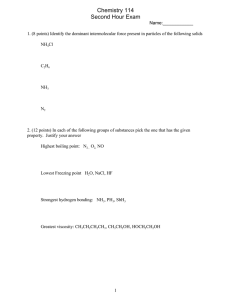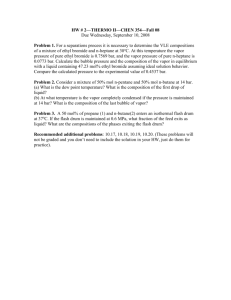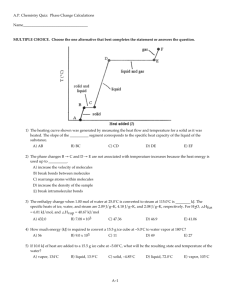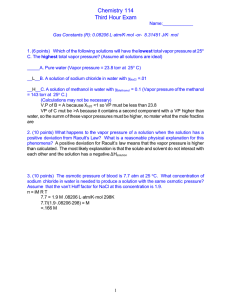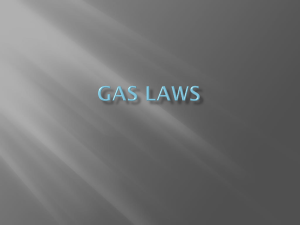Chemistry 114 First Hour Exam Name:____________ Please show all work for partial credit
advertisement
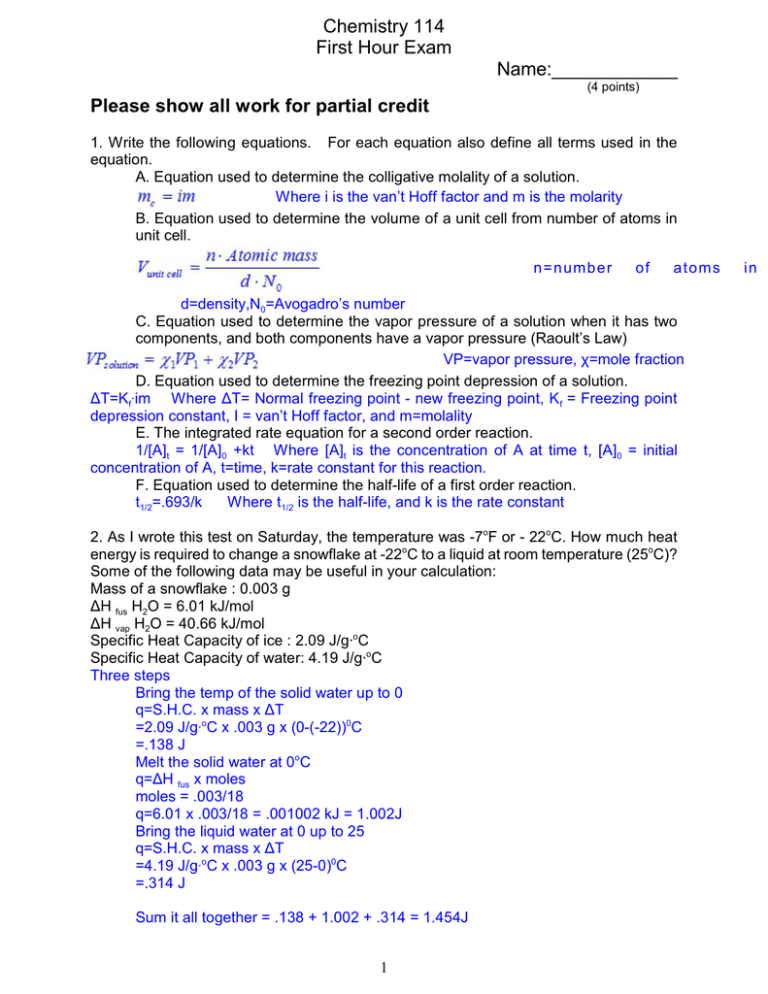
Chemistry 114 First Hour Exam Name:____________ (4 points) Please show all work for partial credit 1. Write the following equations. For each equation also define all terms used in the equation. A. Equation used to determine the colligative molality of a solution. Where i is the van’t Hoff factor and m is the molarity B. Equation used to determine the volume of a unit cell from number of atoms in unit cell. n=n umber of atoms d=density,N0=Avogadro’s number C. Equation used to determine the vapor pressure of a solution when it has two components, and both components have a vapor pressure (Raoult’s Law) VP=vapor pressure, ÷=mole fraction D. Equation used to determine the freezing point depression of a solution. ÄT=KfAim Where ÄT= Normal freezing point - new freezing point, Kf = Freezing point depression constant, I = van’t Hoff factor, and m=molality E. The integrated rate equation for a second order reaction. 1/[A]t = 1/[A]0 +kt Where [A]t is the concentration of A at time t, [A]0 = initial concentration of A, t=time, k=rate constant for this reaction. F. Equation used to determine the half-life of a first order reaction. t1/2=.693/k Where t1/2 is the half-life, and k is the rate constant 2. As I wrote this test on Saturday, the temperature was -7oF or - 22oC. How much heat energy is required to change a snowflake at -22oC to a liquid at room temperature (25oC)? Some of the following data may be useful in your calculation: Mass of a snowflake : 0.003 g ÄH fus H2O = 6.01 kJ/mol ÄH vap H2O = 40.66 kJ/mol Specific Heat Capacity of ice : 2.09 J/g@oC Specific Heat Capacity of water: 4.19 J/g@oC Three steps Bring the temp of the solid water up to 0 q=S.H.C. x mass x ÄT =2.09 J/gAoC x .003 g x (0-(-22))0C =.138 J Melt the solid water at 0oC q=ÄH fus x moles moles = .003/18 q=6.01 x .003/18 = .001002 kJ = 1.002J Bring the liquid water at 0 up to 25 q=S.H.C. x mass x ÄT =4.19 J/gAoC x .003 g x (25-0)0C =.314 J Sum it all together = .138 + 1.002 + .314 = 1.454J 1 in 3. Zinc has a density of 7.14 g/cm3. Assuming it crystalizes in a body centered cubic lattice, determine the volume of its unit cell. Body centered cubic has 2 atoms per unit cell so n=2 =2(65.38)/7.14(6.022x1023) =3.04x10-23 cm3 4. Vinegar is 5% acetic acid (CH3COOH) by mass. A. What is the mole fraction of acetic acid in vinegar? 5% by mass says that for every 100 g of solution 5 g is acetic acid and 95 g is water molar mass of acetic acid = 2(12) + 2(16) + 4(1) = 60 molar mass water = 16+2(1) =18 moles acetic acid = 5/60 = .0833 moles moles water = 95/18 = 5.28 mole fraction acetic acid = .0822/(.0833+5.28) = .0155 B. What is the molality of acetic acid in vinegar? Moles acetic acid/kg of water =.0833/.095 kg = 0.877m 2 5. 1-Propanol has a molar mass of 60.1 g/mol and a vapor pressure of 1.99 kPa @20oC Acetone has a molar mass of 58.08 g/mol amd a vapor pressure of 24.5 kPa @ 20oC. A. If I mix 120.2 grams of 1-propanol and 58.08 g of acetone, what is the vapor pressure of the solution? 120.2 g propanol/60.1 g/mol = 2 mol propanol 58.08 g acetone/58.08 g/mol = 1 mol acetone VP = 1.99(2/3) + 24.5x(1/3) =9.49 kPa B. If the actual vapor pressure is higher than this value, what does it tell me about the interactions between 1-Propanol and Acetone in the solution? Higher vapor pressure is a positive deviation from Raoult’s law and this indicates poor interaction between solvent and solute molecules. 6. Define the following terms Enthalpy of fusion Heat required to change 1 mole of solid when the temperature is at the melting point of the material. Normal boiling point The temperature at which the liquid and the gas have the same vapor pressure, and the vapor pressure is 1 atm. Viscosity Resistance to flow. Triple point The point on a phase diagram where three different phases of a material all coexist at one temperature and pressure. Osmotic pressure The pressure required to prevent the flow of a solvent into a solution that is inside a semi-permeable membrane. Distillation Heating a solution until it turns into a vapor, and then condensing the vapor back into a liquid. This process serves to concentrate the component of the solution which has the higher vapor pressure. 1st order reaction A reaction in which the order parameter is 1 3 7. I have a first order reaction with a rate constant of 10 min-1. If I start with a .1M solution of the reactant, how long will it take before 75% of the reactant has disappeared? Ln[A]t = ln[A]0 -kt [A]0 = .1M 75% has disappeared means 25% remains so [A]t = .25(.1) = .025 ln(.025) = ln(.1) -(10)X -3.689 = -2.303 -10X -3.689 + 2.303 =-10X -1.386 =-10X -1.386/-10 =X X = .139 minutes 8. A second order reaction has a half-life of 10 minutes when the reactant concentration is .1M. What will be the half-life of the reaction when the reactant concentration is .03 M? t1/2 = 1/(k[A] 10 = 1/k(.1) k=1/[10x.1] k=1 t1/2 = 1/1(.03) =33.3 minutes 4
